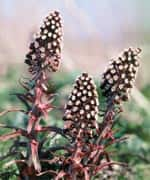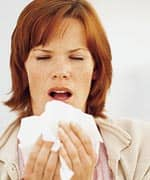Life Extension Magazine®
For hay fever sufferers, European clinical studies have demonstrated that butterbur, a flowering herb, can be as effective as the leading allergy drugs Zyrtec® and Allegra®. This represents a remarkable breakthrough for all allergy patients—they can now be free of the debilitating side effects of traditional antihistamines used to treat allergies, including palpitations, severe drowsiness, and fatigue. Additional research has identified rosmarinic acid as an aid in normalizing the inflammation and immune response that accompany allergic reactions. Together, these two botanical agents offer great relief for many of the nearly 40 million Americans now suffering from allergic rhinitis (hay fever). Butterbur: Herbal Help from EuropeButterbur has a long history of medicinal applications throughout Europe. As early as the Middle Ages, butterbur root—Petasites hybridus—was used to alleviate infections and fevers. Later, the herb was used in Europe, northern Africa, and Asia to treat coughs, congestion, and asthma. Butterbur’s principal active constituents include petasin and isopetasin, phytochemicals that may reduce spasms in smooth muscle and relax swollen nasal membranes.1 The active ingredients in butterbur inhibit leukotriene synthesis, consistent with butterbur’s anti-spasm and anti-inflammatory properties.2,3 In the last 30 years, a standardized preparation of butterbur has been recognized as an effective treatment for hay fever in Europe, where herbal remedies must undergo rigorous testing before they can be used by the general public. Repeated studies have shown that butterbur (standardized for petasin and isopetasin) dramatically improves breathing and reduces the effects of histamine and nasal congestion, all without side effects. Let’s take a look at some of these remarkable findings.
The first randomized, double-blind study of standardized butterbur extract, reported by Swiss researchers in the British Journal of Medicine in 2002, followed 125 seasonal hay fever sufferers. At four clinics in Switzerland and Germany, 61 patients were treated with one tablet of the butterbur extract (containing 8 mg of petasin) four times a day, and 64 patients were treated with 10 mg of cetirizine (Zyrtec®) taken once daily. All participants had suffered seasonal allergies for two or more consecutive years. In skin testing, all but one of the 125 patients proved to be allergic to pollens, most commonly grass pollens.4 After two weeks of daily treatment, all participants were judged by their physicians to be improved in clinical examinations. All were shown to have been exposed to substantial levels of pollen during the preceding two weeks, through cross-checking the treatment period with the German government’s pollen-count service. What the researchers noted as most significant was that in every category, butterbur scored as well as cetirizine in alleviating symptoms. While drowsiness and fatigue accounted for two thirds of the adverse events reported by patients in the cetirizine group during the treatment period, these side effects were not noted among those taking the butterbur extract. “We set out to test whether [butterbur’s] clinical effects in seasonal allergic rhinitis (seasonal allergies) were comparable to those of antihistamines as judged separately and blindly by patients and their doctors,” wrote study author Dr. Andreas Schapowal. “The results showed that the effects of the two treatments are similar . . . With regard to safety, butterbur was well tolerated and did not have the sedative effects associated with antihistamines.” 4
In another study conducted in Switzerland, six patients with acute allergic rhinitis received two butterbur tablets three times a day. At the study’s conclusion, the Swiss researchers were impressed by the significantly lower levels of the inflammatory mediators histamine and leukotrienes in the study participants. They also found that the patients’ breathing reached normal parameters by the end of the five-day period. All the people involved in the study reported significant improvement on a quality-of-life questionnaire, where they rated their symptoms as being above average on the first day and well below average at the end of five days of treatment.5 Butterbur’s Effects Comparable to DrugsOne of the leading researchers on the benefits of butterbur, Dr. Schapowal has conducted numerous studies of this herb. His findings enthusiastically endorse butterbur as an effective treatment and a replacement for pharmaceuticals in the management of seasonal allergies. At the end of one of his placebo-controlled trials involving 330 patients, Dr. Schapowal concluded: “The effects of [standardized butterbur extract] in treating the symptoms of intermittent allergic rhinitis are similar to those of the antihistamine fexofenadine when evaluated blindly by patients and doctors. Butterbur does not exhibit the sedative effects often associated with antihistamines and is well tolerated by patients. Despite being an herbal drug, butterbur has now been subject to a series of well-controlled trials and should be considered as an alternative treatment for [intermittent allergic rhinitis (seasonal allergies)].”7 Dr. Schapowal and his colleagues studied butterbur’s efficacy once more in 2004, comparing treatment with high and low doses of the plant extract to placebo in a double-blind trial. At the end of the two-week period, physicians’ clinical assessments of the response to treatment indicated that those receiving the high and low doses of butterbur improved dramatically compared to those who received placebo. Moreover, the group receiving the higher dose of butterbur extract showed significantly better results than the low-dose group.7 Scottish Study Confirms Butterbur’s EfficacyAt roughly the same time that Dr. Schapowal and his colleagues were studying butterbur’s efficacy compared to Allegra® (fexofenadine) in Switzerland, another research team was evaluating and comparing the two at the University of Dundee in Scotland. In that trial, 16 patients suffering from symptoms caused by allergic reaction to dust mites received one week of therapy with 100 mg of butterbur daily, 180 mg of fexofenadine (Allegra®) daily, or placebo. The study purposely was conducted outside Scotland’s pollen seasons in order to eliminate potentially confounding environmental allergens. Following one week of treatment, both objective and subjective measurements showed that butterbur and fexofenadine significantly improved symptoms of rhinitis compared to placebo. Butterbur performed slightly better than fexo-fenadine in a test of the patients’ response to a spray that triggered nasal congestion. “We were able to demonstrate significant improvement in the total nasal symptom score with both butterbur and fexofenadine compared to placebo,” wrote study author Dr. Daniel K. Lee. “Our results demonstrated that both butterbur and fexofenadine were equally effective, compared to placebo, in attenuating the nasal response to [congestion-provoking] challenge in addition to improving nasal symptoms in patients with perennial allergic rhinitis.”8
These results mirrored those of a previous study by Dr. Lee and his colleagues in which 20 patients shown to be allergic to grass pollens via skin tests were treated with 100 mg of butterbur daily or placebo. In response to the introduction of the congesting nasal spray, patients taking butterbur regained nasal air flow more quickly than did those taking placebo. The study authors noted that their findings suggest that butterbur may be an effective therapeutic for people suffering from seasonal allergic rhinitis.9 Butterbur may have additional applications for people suffering from upper respiratory complications such as asthma. Several studies have looked at the possibility of incorporating butterbur in an asthmatic treatment program. Because people who suffer from allergic rhinitis have a higher incidence of asthma than does the general population, recent studies showing butterbur’s effectiveness in treating that upper-respiratory disorder as well are very encouraging.10 In 2003, Dr. Lee and his associates at the University of Dundee found that patients who treated their asthma with inhaled corticosteroids breathed better when they added 25 mg of butterbur twice daily to their treatment regimen.11 In an open trial at the University of Heidelberg in Germany, 64 adults and 16 children with asthma reported a decrease in the number, duration, and severity of asthma attacks during two months of butterbur therapy compared to baseline. In addition, the participants demonstrated improvements in forced expiratory volume, a measure of the amount of air exhaled in a forced breath. Participants were allowed to use other asthma medications as needed during this two-month trial.12 | ||||
Allergy Assistance from Rosmarinic AcidIn addition to butterbur, another efficacious herb for the treatment of the immune response to allergens has come under examination. Studies have found that rosmarinic acid can reduce the symptoms of an allergic response. Rosmarinic acid is a polyphenol found in a number of plants in the Lamiaceae family—including basil, mint, perilla leaf, rosemary, and sage. Rosmarinic acid acts in response to allergies via a mechanism very different from that of butterbur. Instead of reducing inflammation and quieting spasms in affected airways, rosmarinic acid prevents the activation of immune responder cells and induces cell death (apoptosis) in already activated responder cells.13 What is remarkable is rosmarinic acid’s ability to kill off only unneeded allergy-activated T-cells triggered by the body’s immune response, while sparing the vast numbers of T-cells required to ward off bacteria, viruses, and other invaders.14 Antihistamines, by contrast, have no ability to act on and destroy excessive immune cells.15
In 2004, a team of Japanese researchers documented how daily treatment with rosmarinic acid extract prevented allergic asthma caused by house mites in laboratory mice.16 In a critically important trial in humans, the Japanese research team conducted a 21-day, double-blind, placebo-controlled test of rosmarinic acid’s ability to control seasonal allergic rhinoconjuctivitis. Patients were treated with 50 or 200 mg of the natural supplement or placebo daily, and each kept a daily diary of symptoms. By day three, the two groups taking the high and low doses of rosmarinic acid demonstrated significantly lower levels of immune cells in laboratory examinations of nasal fluids when compared to the control group. Symptoms of swollen, itchy, and watery eyes were particularly reduced in the rosmarinic acid groups. No side effects were reported by any of the three subject groups, and extensive blood cell counts and tests of liver and kidney function showed the treatment to be safe and non-toxic.17 This 2004 trial was the first sophisticated study of rosmarinic acid’s effects on allergies in humans. Its authors concluded that relief from seasonal rhinitis symptoms can be achieved by reducing the number of immune cells activated by the allergic response.17 Additional trials are under way in hope of learning much more about the this supplement’s mechanisms and optimal usage. In a further trial, the Japanese team again treated patients suffering from seasonal allergic rhinitis with either rosmarinic acid or placebo. The participants receiving rosmarinic acid reported improvements in all of their allergy symptoms. These benefits were accompanied by decreased numbers of immune cells present in nasal secretions. In order to elucidate rosmarinic acid’s mechanism of action, the scientists used a research model of laboratory animals. In this animal model, they found that rosmarinic acid acted by two distinct mechanisms: inhibiting the inflammatory response and scavenging reactive oxygen species, a source of oxidative stress.18
Strategies for Avoiding AllergensPeople who suffer from the seasonal or perennial effects of allergic rhinitis can mitigate their symptoms by avoiding allergens as best they can. However, pollens are everywhere in the outdoor air and can be difficult to avoid. While staying indoors during the height of a season in which a particular type of pollen is present is not practical for most people, limiting exposure can provide at least modest relief. Pollen counts tend to be high on dry, sunny, windy days, and people with allergic rhinitis should stay indoors on those days, if possible. Keeping the windows and doors of houses and cars closed as much as possible during the pollen season also can be helpful, especially if air conditioning or fans are set in re-circulating mode to block the intake of outside air. Showering following outdoor exposure removes pollen that collects on the skin and hair, and may be helpful as well. Controlling indoor allergens is often more successful. Dust mites can be combated by covering mattresses and pillows with impermeable covers, and bed linens should be regularly washed in 130-degree water, which kills any mites present. Thorough vacuum-cleaning of carpets and rugs is wise, but wall-to-wall carpeting should be avoided by people with proven dust-mite allergies. Dust mites thrive when the indoor humidity level rises above 50%, so dehumidifiers, air conditioners, or both also help limit mite populations. Completely avoiding domestic animals is the best way to limit allergy symptoms for those sensitive to pet dander. For pet lovers who cannot or choose not to live without animals, keeping pets in carpet-free rooms and out of bedrooms offers at least some benefit from dander exposure. High-efficiency particulate air (HEPA) filters and ozone purifiers also help keep pet dander out of household air.1 People who suffer either seasonal or perennial rhinitis are generally advised to avoid as best they can environmental pollutants, pesticides, car exhaust, cigarette smoke, perfumes, and new carpeting—all of which can trigger allergic responses and worsen ongoing allergies. Drinking pure filtered water is wise, as is using hypoallergenic products when they are available. ConclusionFor many individuals, lifestyle changes and environmental controls do not provide adequate relief from allergic rhinitis’s often miserable symptoms. Almost everyone with at least moderate allergies requires some form of treatment. For those who have long hoped for a clinically proven herbal treatment—free of the sedating side effects and other drawbacks of pharmaceutical drugs—the scientifically proven efficacy of butterbur and rosmarinic acid in limiting congestion, swelling, watery eyes, and post-nasal drip represents an exciting breakthrough. Additional studies may offer further insight into how these plant-derived supplements can provide much-needed relief from both seasonal and year-round allergies. | |||
| References | |||
| 1. No authors. Monograph. Petasites hybridus. Altern Med Rev. 2001 Apr;6(2):207-9. 2. Bickel D, Röder T, Bestmann HJ, Brune K. Identification and characterization of inhibitors of peptido-leukotriene synthesis from Petasites hybridus. Planta Med. 1994 Aug;60(4):318-22. 3. Thomet OA, Wiesman UN, Schapowal A, Bizer C, Simon HU. Role of petasine in the potential anti-inflammatory activity of a plant extract of Petasites hybridus. Biochem Pharmacol. 2001 Apr 15;61(8):1041-7. 4. Schapowal A. Petasites Study Group. Randomized controlled trial of butterbur and cetirizine for treating seasonal allergic rhinitis. BMJ. 2002 Jan 19;324(7330):144-6. 5. Thomet O, Schapowal A. Henishc I, Wiesmann U, Simon H. Anti-inflammatory activity of an extract of Petasites hybridus in allergic rhinitis. Int Immunopharmacol. 2002 Jun;2(7):997-1006. 6. Schapowal A. Treating intermittent allergic rhinitis: a prospective, randomized, placebo and antihistamine-controlled study of butterbur extract Ze 339. Pystother Res. 2005;19(6):530-7. 7. Schapowal A. Petasites Study Group. Butterbur Ze 339 for the treatment of intermittent allergic rhinitis. Arch Otolarynol Head Neck Surg. 2004 Dec;130(12):1381-6. 8. Lee DK, Gray RD, Robb FM, Fujihara S, Lipworth BJ. A placebo-controlled evaluation of butterbur and fexofenadine on objective and subjective outcomes in perennial allergic rhinitis. Clin Exp Allergy. 2004 Apr;34(4):646-9. 9. Lee DK, Carstairs IJ, Haggart K, Jackson CM, Currie GP, Lipworth BJ. Butterbur, a herbal remedy, attenuates adenosine monophosphate induced nasal responsiveness in seasonal allergic rhinitis. Clin Exp Allergy. 2003 Jul;33(7):882-6. 10. Mauskop A. Petasites hybridus; ancient medicinal plant is effect prophylactic treatment for migraine. Townsend Lett. 2000;202:104-6. 11. Lee DK, Haggart K, Robb FM, Lipworth BJ. Butterbur, a herbal remedy, confers complementary anti-inflammatory activity in asthmatic patients receiving inhaled corticosteroids. Clin Exp Allergy. 2004 Jan;34(1):110-4. 12. Danesch U. Petasites hybridus (butterbur root) extract in the treatment of asthma—an open trial. Altern Med Rev. 2004 Mar;9(1):54-62. 13. Hur YG, Yun Y, Won J. Rosmarinic acid induces p561ck-dependent apoptosis in jurkat and peripheral T cells via mitochondrial pathway independent from fas/fas ligand interaction. J Immunol. 2004 Jan 1;172(1):79-87. 14. Sanbongi C, Takano H, Osakabe N, et al. Rosmarinic acid inhibits lung injury induced by diesel exhaust particles. Free Radic Biol Med. 2003 Apr 15;34(8):1060-9. 15. Wong BR, Grossbard EB, Payan DG, Masuda ES. Targeting Syk as a treatment for allergic and autoimmune disorders. Expert Opin Investig Drugs. 2004 Jul;13(7):743-62. 16. Sanbongi C, Takano H, Osakabe N, et al. Rosmarinic acid in perilla leaf extract inhibits allergic inflammation induced by mite allergen, in a mouse model. Clin Exp Allergy. 2004 Jun;34(6):971-7. 17. Takano H, Osakabe N, Sanbongi C, et al. Extract of Perilla frutescens enriched for rosmarinic acid inhibits seasonal allergic rhinoconjunctivitis in humans. Exp Biol Med. 2004 Mar;229(3):247-54. 18. Osakabe N, Takano H, Sanbongi C, et al. Anti-inflammatory and anti-allergic effect of rosmarinic acid (RA); inhibition of seasonal allergic rhinoconjunctivitis (SAR) and its mechanism. Biofactors. 2004;21(1-4):127-31. |






